CANTON EXPRESS
A collective project by Cantonese artists for the
exhibition “Z.O.U. -- Zone of Urgency” (curated by Hou Hanru) for the Venice
Biennale 2003
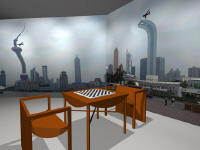 |
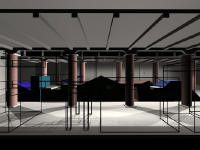 |
 |
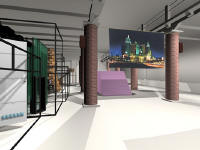 |
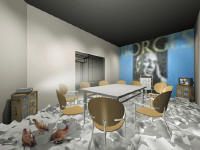 |
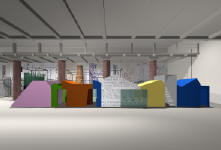 |
1.
Canton (Guangzhou) and its neighboring region, the Pearl River Delta, are
historically the most important Chinese port opening towards the outside world.
For the last century, this area has always been the most avant-garde laboratory
of China’s modernization. The first revolution to replace the Qing Dynasty with
a Republic of China originated from here while the region has always remained
relatively independent in terms of economy, social life and cultural identity in
the vast territory of China. Its main language Cantonese is no doubt the most
open, flexible diverse, evolutional and closest to life among the highly various
Chinese dialects. It contradictorily conserves a part of the most ancient
Chinese language while entirely exposed to influences from foreign languages,
notably English. This makes it a unique system of hybrid expressions and
memories. The visual arts as well as the Cantonese literature, drama and music
has also been a highly hybrid product of its particular geo-historic position.
“Lingnan School”, born in the wave of the first modernization attempts in late
Qing Dynasty, promotes a new imagery and world vision mixing up traditional ink
painting and Western style of realistic perception mode and technique.
In the last two decades, Canton and Pearl River have, once again, become the
most intensive laboratory of China’s modernization. New “Special Economic Zones”
like Shen Zhen and Zhu Hai have been constructed out of no-man’s lands on an
unprecedented speed – “Shenzhen Speed”, which Rem Koolhaas praised as “an
unprecedented system of efficiency”. In the meantime, From Canton to Hong Kong
and Macao, via the whole Pearl River Delta, radically rapid urbanization has
transform this part of China into one of the most spectacular and exciting zone
of economic and social modernization on the earth. A new cultural scene has also
been invented. Instead of the “avant-garde” movement based on ideological
confrontation that has dominated China’s “mainstream” cultural world, the
Cantonese scene, like its language itself, has been much more open to diversity
and differences, and closely linked to the unique Cantonese Pop Culture. Born in
the incessant movement between Hong Kong, Taiwan, Japan, South Eastern Asia,
Western influences and Cantonese contexts, this particular Pop Culture, with its
widely distributed music, films and TV-multimedia products, is now becoming the
cultural condition of South Eastern Asia and China’s societies. Artists living
in Canton and its surrounding are involved directly in the making of such a
condition. On the other hand, contradictory, the lack of a market for “elitist”
artistic works makes the artists to deal with their reality with a more radical
attitude. Their works are much more experimental, flexible, non-commercial and
hence completely free and limitless. They act like urban guerrillas. They create
the most fantastically imagined ideas, products, actions and events to intervene
and interrupt urban life and provoke dreamlike moments in our life. Their
actions are rapid, efficient, but full of sense of humor and pungent critiques
vis-à-vis real life. This makes them a unique and perhaps the most interesting
part of China’s contemporary art scene for today. The project “Canton Express”,
initiated by the curator, is conceived collectively by different groups of
artists from the region to provide a specific space in which one can experience
their fascinating adventure of play and invention, to navigate and negotiate in
the dynamic currents of the drastic transformation of this part of the planet.
2
The Canton Express is a project proposed collectively by several groups of
artists, writers, filmmakers, designers, musicians and cultural activists from
Canton and the Pearl River Delta. These groups have been collaborated in
different common actions in the last decade while developing individual
identities. Under the names of Big Tail Elephants (Chen Shaoxiong, Liang Juhui,
Lin Yilin and Xu Tan), Borges Bookstore (Chen Tong et al.), Yangjiang
Group/World Bookstore/Vitamin Creative Space( Zheng Guogu, Hu Fang, Feng Qianyu,
Chen B. Lu Yi, etc.), Utèque (Ou Ning, Cao Fei, etc.) and other individuals
(Yang Yong, Liu Heng, Feng Feng, and many others), they have been the main
driving force of the Cantonese and Southern Chinese experimental artistic and
cultural scene. Their activities and products span across the most various
fields from visual arts, performance, film making, books, magazines, conferences
and other kinds of forms of existence. With critical views and great sense of
humor, their works penetrate deeply into the everyday life and provoke moments
of excitements and enlightenments. They are a highly distinct and unique force
in the dynamic scene of contemporary art and culture development in South East
Asia. Canton Express, consisting of activities and events organised by the
groups in a specifically constructed structure designed by the groups, intends
open a space for the public, from both “local” and “global” communities, to
encounter with their highly exciting work and experience the particular relation
between their imagination and their living environments, notably the turbulently
mutating urban environments. This can perfectly embody the proposal of the
exhibition “Zone of Urgency”, curated by Hou Hanru for the upcoming 50th Venice
Biennale. In the project (see figures attached), they will produce site-specific
“exhibitions” in and around the structure that they invent out of the street
life in Canton and open them to welcome the intervention of the public. The
whole installation and event will become a temporary city inserted in the
Arsenale like a grafted urbanization process. It will bring new and real life
into the enclosure of a contemporary art museum. It will be an exceptional
moment for the visitors to enjoy a radical shift in their city – to share the
joy, dreams and problems of a tropical Asian city’s life…
3. Project 1
Canton Express structure :
General Design : Zheng Guogu, inland coordination: Vitamin Creative Space,
Guangzhou (Zhang Wei)
1. Big Tail Elephants:
a. Lin Yilin: 6 performances on video, 6 monitors/DVD players.
b. Chen Shaoxiong: new piece. 2 projectors with DVD players.
c. Xu Tan
d. Liang Juhui
2. Yangjiang group :
a. Zheng Guogu
b. Feng Qianyu
c. Sha Yeya, cardboard with a “building” inside
d. Lu Yi
3. Borges Liberia/Literature
a. Chen Tong: publications and documents of the BL.
b. Hu Fang: two kinds of “sub-literature”: Dagong Wenxue (new proletariat
literature); Chuanmei Wenxue (Media Literature – most of professional writers
work in the mass media, a new form of narrative).
c. Jiang Zhi: videos ?
4. Utèque (Yuanying Hui) and underground publications:
Exploring with audio-video means the history of “Sanyuan Li”, a historically
symbolic (anti-colonialism) area in Guangzhou, now turned into a kind of
extra-territorial (“walled city”) area. The village inside the city. A space of
“alternative history”.
Video –film: collaboration with Jia Zhangke to document the situation and
historic background.
Audio: concerts of experimental music such as Zbijniew Karkowski in Guangzhou’s
underground café.
Underground publications and literature presentations (reading events).
Linked with internet to broadcast/interactive the event and the special
history/reality of Guangzhou and Cantonese culture.
5. Beyond:
a. Yang Jiechang (Paris – the oversea’s connection)
b. Cao Fei: videos
c. Yang Yong: two-three channel slide projections.
d. Lui Heng: architectural aspect.
 |
 |
 |
||
 |
 |
|||
 |